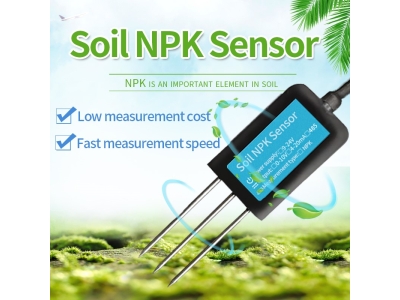Agriculture has been the backbone of human civilization, providing food and raw materials for generations. However, to meet the growing demand for food and reduce the environmental impact of agriculture, there is a need to improve crop yield and sustainability. Precision agriculture, enabled by technological advancements, has emerged as an effective strategy to achieve these goals. Soil sensor systems are one such innovation that has gained popularity in recent years. This article aims to explore how soil sensor systems can enhance crop yield and sustainability.
I. Understanding Soil Sensor Systems:
Soil sensor systems consist of sensors that measure various soil properties, such as moisture, temperature, pH, nutrient levels, and organic matter content. These sensors can be installed at different depths in the soil to monitor the soil environment where the crops grow. The data collected by the sensors can be analyzed to make informed decisions about irrigation, fertilization, and other crop management practices.
II. Benefits of Soil Sensor Systems:
Optimizing Irrigation Practices: Soil moisture sensors are the most common type of soil sensor system used in precision agriculture. These sensors can provide real-time data on soil moisture levels, enabling farmers to optimize irrigation practices. Over- or under-watering can lead to reduced crop yield, poor quality, and increased water usage. By using soil moisture sensors, farmers can apply water only when needed, reducing water consumption and increasing crop yield and quality.
Improved Nutrient Management: Soil sensor systems can also help farmers manage soil nutrients more effectively. Soil nutrient sensors can measure the levels of nutrients in the soil and help farmers determine the right amount of fertilizers to apply. This can reduce the use of excess fertilizers, which can be environmentally harmful and costly. By applying fertilizers more precisely, farmers can also improve crop yield and quality.
Enhanced Crop Health Monitoring: Soil sensor systems can provide real-time data on soil temperature, pH, and other parameters that can affect crop health. By monitoring these parameters, farmers can detect early signs of stress or disease and take preventive measures. This can help maintain crop health and reduce yield losses.

Resource Efficiency: Soil sensor systems can contribute to resource efficiency by reducing the amount of water and fertilizers used in agriculture. This can lead to lower costs and reduced environmental impact. By using soil sensors, farmers can apply water and fertilizers more precisely, reducing waste and improving resource utilization.
III. Limitations and Challenges:
Cost: The cost of soil sensor systems can be a limiting factor for small-scale farmers or those with limited resources. However, the cost of soil sensors has been decreasing over time, and with wider adoption, economies of scale can further reduce the cost.
Data Interpretation: The large amounts of data generated by soil sensor systems can be challenging to interpret, particularly for farmers who may not have a background in data analysis. To overcome this challenge, user-friendly interfaces and decision support tools can be developed to help farmers interpret and use data more effectively.
Calibration: Soil sensor systems require regular calibration to ensure accurate measurements. Calibration protocols and standards need to be established to maintain consistency and reliability in the data collected by various sensors.
IV. Future Directions:
Integration with other Technologies: The integration of soil sensor systems with other precision agriculture-related technologies, such as satellite imagery and machine learning, holds great potential for improving crop yield and sustainability. By combining data from different sources, farmers can gain new insights into crop growth and environmental conditions and make more informed decisions.
Standardization: The development of industry-wide standards for soil sensor systems can promote interoperability, facilitate comparison between different systems, and improve their overall quality.
Increased Adoption: Wider adoption of soil sensor systems can significantly benefit the agricultural sector by increasing crop yield, reducing resource usage, and enhancing sustainability. To achieve this, more education and awareness campaigns can be conducted to promote the use of soil sensor systems among farmers.
Conclusion:
Soil sensor systems can play a critical role in enhancing crop yield, resource utilization, and environmental sustainability. By providing real-time data on soil conditions, soil sensor systems enable farmers to make informed decisions about irrigation, fertilization, and other crop management practices. The benefits of soil sensor systems can be further enhanced by integrating them with other precision agriculture technologies, such as satellite imagery and machine learning. Although there are challenges associated with the adoption of soil sensor systems, continued innovation, awareness campaigns, and standardization efforts can overcome these obstacles and promote their wider adoption. Ultimately, enhancing crop yield and sustainability with soil sensor systems can help meet the growing demand for food while minimizing the environmental impact of agriculture.






